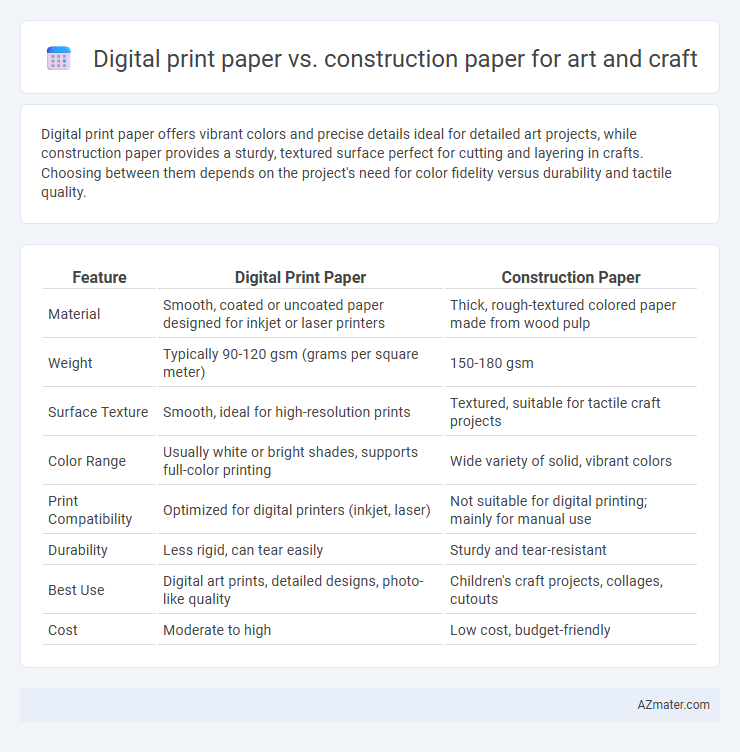Digital print paper offers vibrant colors and precise details ideal for detailed art projects, while construction paper provides a sturdy, textured surface perfect for cutting and layering in crafts. Choosing between them depends on the project's need for color fidelity versus durability and tactile quality.
Table of Comparison
| Feature | Digital Print Paper | Construction Paper |
|---|---|---|
| Material | Smooth, coated or uncoated paper designed for inkjet or laser printers | Thick, rough-textured colored paper made from wood pulp |
| Weight | Typically 90-120 gsm (grams per square meter) | 150-180 gsm |
| Surface Texture | Smooth, ideal for high-resolution prints | Textured, suitable for tactile craft projects |
| Color Range | Usually white or bright shades, supports full-color printing | Wide variety of solid, vibrant colors |
| Print Compatibility | Optimized for digital printers (inkjet, laser) | Not suitable for digital printing; mainly for manual use |
| Durability | Less rigid, can tear easily | Sturdy and tear-resistant |
| Best Use | Digital art prints, detailed designs, photo-like quality | Children's craft projects, collages, cutouts |
| Cost | Moderate to high | Low cost, budget-friendly |
Understanding Digital Print Paper: Features and Uses
Digital print paper offers high-resolution color reproduction and smooth texture, making it ideal for detailed art and craft projects requiring vibrant prints and precise imagery. Its compatibility with laser and inkjet printers allows for customization and mass production, supporting diverse creative applications such as scrapbooking, card making, and decorative prints. Unlike construction paper, digital print paper provides consistent thickness and surface finish, enhancing the quality of printed designs and fine details.
What Is Construction Paper? Characteristics and Applications
Construction paper is a coarse, colored paper often made from wood pulp, characterized by its durability, textured surface, and vibrant, solid hues ideal for hands-on art and craft projects with children. Its thickness and rough texture allow easy cutting, folding, and gluing, making it suitable for collages, paper sculptures, and school projects that require sturdy, reliable materials. Commonly used in educational settings, construction paper supports creative activities that demand both flexibility and resilience, contrasting with the smooth finish and higher resolution of digital print paper.
Texture and Finish: Comparing Paper Surfaces
Digital print paper features a smooth, consistent texture ideal for detailed graphic designs and sharp color reproduction, enhancing precision in art projects. Construction paper has a rougher, fibrous surface that offers tactile quality and a matte finish, suited for hands-on crafts and layering techniques. The choice between these papers depends on whether a sleek, polished look or a textured, natural feel is desired for the artwork.
Color Range and Vibrancy: Which Paper Stands Out?
Digital print paper offers a wider color range and higher vibrancy due to advanced ink absorption that enhances sharpness and brightness, making it ideal for detailed, colorful projects. Construction paper has more limited color options and tends to have a matte finish, resulting in less vivid hues but providing a traditional, tactile feel preferred for children's crafts. For projects demanding bold, crisp colors, digital print paper stands out, while construction paper favors simplicity and texture.
Durability and Strength for Art Projects
Digital print paper offers high-quality surface texture ideal for detailed artwork but generally lacks the thickness and rigidity required for heavy-duty art and craft projects. Construction paper provides superior durability and strength, making it more suitable for projects involving cutting, folding, and layering due to its denser fiber composition. For long-lasting and structurally demanding art projects, construction paper is preferred because it better withstands handling and environmental wear.
Compatibility with Art Supplies: Markers, Paints, and More
Digital print paper exhibits excellent compatibility with markers and paints, providing smooth surfaces that prevent bleeding and support vibrant color application, making it ideal for detailed artwork. Construction paper, while textured and thick, is better suited for dry media like crayons and colored pencils but may absorb paints unevenly and cause marker ink to feather. Artists seeking precision and color fidelity often prefer digital print paper, whereas those working with mixed textures or layering may choose construction paper for its robust feel.
Flexibility and Weight: Handling and Shaping Differences
Digital print paper offers superior flexibility due to its thinner weight and smooth surface, allowing for easier folding, curling, and detailed shaping in art and craft projects. Construction paper is heavier and stiffer, providing more durability but limiting intricate manipulation and causing potential creasing or cracking when bent sharply. The choice between them depends on the desired balance between ease of handling and structural stability in creative applications.
Cost Comparison: Budget Considerations
Digital print paper generally costs more per sheet compared to construction paper, making it less ideal for large-scale or repetitive art projects on a tight budget. Construction paper offers a more affordable option, especially in bulk, without significantly compromising color variety and texture. For cost-conscious crafters, choosing construction paper allows for extensive creative exploration while maintaining budget efficiency.
Eco-Friendliness and Sustainability Factors
Digital print paper often uses eco-friendly soy-based inks and can be recycled, making it a sustainable choice for art and craft projects. Construction paper, while colorful and textured, is typically made from virgin pulp and may contain dyes and chemicals less favorable for the environment. Choosing digital print paper supports reduced waste and lower environmental impact, aligning better with sustainability goals in creative applications.
Best Choice for Specific Art and Craft Projects
Digital print paper offers high-resolution color accuracy and smooth texture, making it ideal for detailed graphic designs, scrapbooking, and photo-based projects. Construction paper provides a thicker, more durable surface with vibrant colors, perfect for hands-on crafts like cutting, folding, and collaging that require sturdiness and texture. For precise, professional-quality prints, digital print paper is the best choice, while construction paper excels in tactile, child-friendly crafting activities.

Infographic: Digital print paper vs Construction paper for Art and craft
 azmater.com
azmater.com